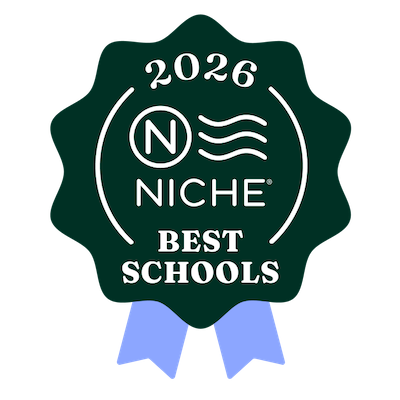Curriculum Detail - Kindergarten
Kindergarten
Kindergarten Curriculum At-a-Glance
Kindergarteners investigate, experiment and discover. They acquire independence over the year; learn when and how to ask others for help; develop responsibility for themselves and others; gain confidence and the social skills crucial to success. During math, girls develop number sense, identify patterns and work with numbers. Girls learn each letter and its corresponding sound, leading the way to reading and writing. Based on findings from Laurel’s Center for Research on Girls, students use growth mindset, an element of resilience, to frame their learning, take appropriate risks and accept challenges. Girls discover that they are learners and feel a strong sense of community within their school. Through a globally immersive curriculum, Kindergarteners travel the world. Teachers transform the classroom into places as diverse as the rainforest, the desert, and the polar regions. Girls have the unique opportunity to explore habitats around the world and discover similarities and differences within our global community. They then apply their knowledge as they consider their place in the world.
K-2 Curricula
Faculty
-
 Bernadette BeroudWorld Languages Teacher, FrenchEducation: Universite des freres Lumiere - B.A.
Bernadette BeroudWorld Languages Teacher, FrenchEducation: Universite des freres Lumiere - B.A.
Universite des freres Lumiere - M.A.
Universite Jean Moulin - D.E.A.Hired: 2013 -
 Catherine ButlerVisual Art TeacherEducation: Cleveland Institute of Art - B.F.A.Hired: 2009
Catherine ButlerVisual Art TeacherEducation: Cleveland Institute of Art - B.F.A.Hired: 2009 -
 Melynda ByrnesDirector of STEAM Education, K-5; STEAM TeacherEducation: University of Utah - B.S.
Melynda ByrnesDirector of STEAM Education, K-5; STEAM TeacherEducation: University of Utah - B.S.
Vassar College - B.A.Hired: 2009 -
 Jennifer CasaEarly Childhood and Kindergarten LibrarianEducation: American University - B.A.
Jennifer CasaEarly Childhood and Kindergarten LibrarianEducation: American University - B.A.
Kent State University - M.A.T.Hired: 2015 -
 Patricia HarpringLearning Specialist, First Grade Teacher, Testing CoordinatorEducation: University of Kentucky - B.A.
Patricia HarpringLearning Specialist, First Grade Teacher, Testing CoordinatorEducation: University of Kentucky - B.A.
University of Louisville - M.Ed.
University of Louisville - M.A.Hired: 2006 -
 Amanda LovePhysical Education Department Chair, Physical Education TeacherEducation: Georgetown University - B.S.
Amanda LovePhysical Education Department Chair, Physical Education TeacherEducation: Georgetown University - B.S.
Columbia University - M.A.Hired: 2017 -
 Joel McDanielMusic Teacher, Primary & Upper Schools; Theater Technical SupportEducation: Baldwin Wallace University - B.M.E.Hired: 2017
Joel McDanielMusic Teacher, Primary & Upper Schools; Theater Technical SupportEducation: Baldwin Wallace University - B.M.E.Hired: 2017 -
 Emily Mervis '06Database CoordinatorEducation: Miami University - B.S.
Emily Mervis '06Database CoordinatorEducation: Miami University - B.S.
Rutgers University - M.L.S.Hired: 2023 -
 Bella PatelDirector of Early Childhood and Primary SchoolsEducation: Vassar College - B.A.
Bella PatelDirector of Early Childhood and Primary SchoolsEducation: Vassar College - B.A.
Teachers College, Columbia University - M.A.Hired: 2003 -
 Ilissa PearlmanSchool Psychologist, Grades K-5Education: University of Michigan - B.A.
Ilissa PearlmanSchool Psychologist, Grades K-5Education: University of Michigan - B.A.
Ohio State University - M.A.
Ursuline College - M.A.
Case Western Reserve University - Ph.D.Hired: 2005 -
 Ida PorrisDance Teacher, Early Childhood & Primary SchoolsEducation: Ohio State University - B.F.A.Hired: 1991
Ida PorrisDance Teacher, Early Childhood & Primary SchoolsEducation: Ohio State University - B.F.A.Hired: 1991 -
 Karen RedmondTechnology Innovation Specialist & Maker MentorEducation: Kent State University - B.A.
Karen RedmondTechnology Innovation Specialist & Maker MentorEducation: Kent State University - B.A.
Ohio State University - M.A.
Ursuline College - M.Ed.
Baldwin Wallace CollegeHired: 2002 -
 Kelli ThomasKindergarten TeacherEducation: Cleveland State University - B.S.Hired: 2016
Kelli ThomasKindergarten TeacherEducation: Cleveland State University - B.S.Hired: 2016 -
 Mary TongelKindergarten TeacherEducation: University of Akron - B.A.Hired: 2013
Mary TongelKindergarten TeacherEducation: University of Akron - B.A.Hired: 2013
Current Grade-level Selection (do not use)
Lyman Campus | Laurel School
1 Lyman Circle
Shaker Heights, OH 44122
Phone: 216-464-1441
Admissions: admissions@LaurelSchool.org
General: info@LaurelSchool.org
Shaker Heights, OH 44122
Phone: 216-464-1441
Admissions: admissions@LaurelSchool.org
General: info@LaurelSchool.org
Butler Campus | Laurel School
7420 Fairmount Road
Novelty, OH 44072
Phone: 216-464-1441
Admissions: admissions@LaurelSchool.org
General: info@LaurelSchool.org
Novelty, OH 44072
Phone: 216-464-1441
Admissions: admissions@LaurelSchool.org
General: info@LaurelSchool.org
© 2025 Laurel School. All Rights Reserved.


























